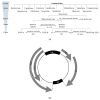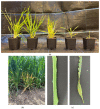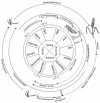The Past, Present, and Future of Wheat Dwarf Virus Management-A Review
- PMID: 37896096
- PMCID: PMC10609771
- DOI: 10.3390/plants12203633
The Past, Present, and Future of Wheat Dwarf Virus Management-A Review
Abstract
Wheat dwarf disease (WDD) is an important disease of monocotyledonous species, including economically important cereals. The causative pathogen, wheat dwarf virus (WDV), is persistently transmitted mainly by the leafhopper Psammotettix alienus and can lead to high yield losses. Due to climate change, the periods of vector activity increased, and the vectors have spread to new habitats, leading to an increased importance of WDV in large parts of Europe. In the light of integrated pest management, cultivation practices and the use of resistant/tolerant host plants are currently the only effective methods to control WDV. However, knowledge of the pathosystem and epidemiology of WDD is limited, and the few known sources of genetic tolerance indicate that further research is needed. Considering the economic importance of WDD and its likely increasing relevance in the coming decades, this study provides a comprehensive compilation of knowledge on the most important aspects with information on the causal virus, its vector, symptoms, host range, and control strategies. In addition, the current status of genetic and breeding efforts to control and manage this disease in wheat will be discussed, as this is crucial to effectively manage the disease under changing environmental conditions and minimize impending yield losses.
Keywords: Geminiviridae; mastrevirus; resistance; resistance breeding; resistance genes; wheat dwarf virus (WDV).
Conflict of interest statement
The authors declare no conflict of interest.
Figures




Similar articles
-
Identification and Validation of Quantitative Trait Loci for Wheat Dwarf Virus Resistance in Wheat (Triticum spp.).Front Plant Sci. 2022 Apr 14;13:828639. doi: 10.3389/fpls.2022.828639. eCollection 2022. Front Plant Sci. 2022. PMID: 35498699 Free PMC article.
-
A Real-Time Loop-Mediated Isothermal Amplification for Detection of the Wheat Dwarf Virus in Wheat and the Insect Vector Psammotettix alienus.Plant Dis. 2021 Dec;105(12):4113-4120. doi: 10.1094/PDIS-10-20-2279-RE. Epub 2021 Dec 3. Plant Dis. 2021. PMID: 34003037
-
First Report of Wheat dwarf virus and Its Vector (Psammotettix provincialis) Affecting Wheat and Barley Crops in Syria.Plant Dis. 2011 Jan;95(1):76. doi: 10.1094/PDIS-09-10-0628. Plant Dis. 2011. PMID: 30743673
-
Important wheat diseases in the US and their management in the 21st century.Front Plant Sci. 2023 Jan 12;13:1010191. doi: 10.3389/fpls.2022.1010191. eCollection 2022. Front Plant Sci. 2023. PMID: 36714765 Free PMC article. Review.
-
Using epidemiological information to develop effective integrated virus disease management strategies.Virus Res. 2004 Mar;100(1):5-30. doi: 10.1016/j.virusres.2003.12.011. Virus Res. 2004. PMID: 15036832 Review.
Cited by
-
Molecular characterization of wheat dwarf virus isolates from Serbia based on complete genome sequences.Front Microbiol. 2024 Nov 6;15:1469453. doi: 10.3389/fmicb.2024.1469453. eCollection 2024. Front Microbiol. 2024. PMID: 39568998 Free PMC article.
-
Distribution of Wheat-Infecting Viruses and Genetic Variability of Wheat Streak Mosaic Virus and Barley Stripe Mosaic Virus in Kazakhstan.Viruses. 2024 Jan 8;16(1):96. doi: 10.3390/v16010096. Viruses. 2024. PMID: 38257796 Free PMC article.
References
-
- Buck K.W. Geminiviruses (Geminiviridae) In: Granoff A., Webster R.G., editors. Encyclopedia of Virology. Academic Press; Cambridge, MA, USA: 1999. pp. 597–606. - DOI
-
- Canto T., Aranda M.A., Fereres A. Climate change effects on physiology and population processes of hosts and vectors that influence the spread of hemipteran-borne plant viruses. Glob. Chang. Biol. 2009;15:1884–1894. doi: 10.1111/j.1365-2486.2008.01820.x. - DOI
-
- Habekuß A., Riedel C., Schliephake E., Ordon F. Breeding for resistance to insect-transmitted viruses in barley—An emerging challenge due to global warming. J. Für Kult. 2009;61:53–61. doi: 10.5073/JfK.2009.02.02. - DOI
-
- Roos J., Hopkins R., Kvarnheden A., Dixelius C. The impact of global warming on plant diseases and insect vectors in Sweden. Eur. J. Plant Pathol. 2011;129:9–19. doi: 10.1007/s10658-010-9692-z. - DOI
-
- Ziesche T.M., Bell J., Ordon F., Schliephake E., Will T. Long-term monitoring of insects in agricultural landscapes. Mitteilungen Der DGaaE. 2020;22:101–106.
Publication types
Grants and funding
LinkOut - more resources
Full Text Sources
Miscellaneous

